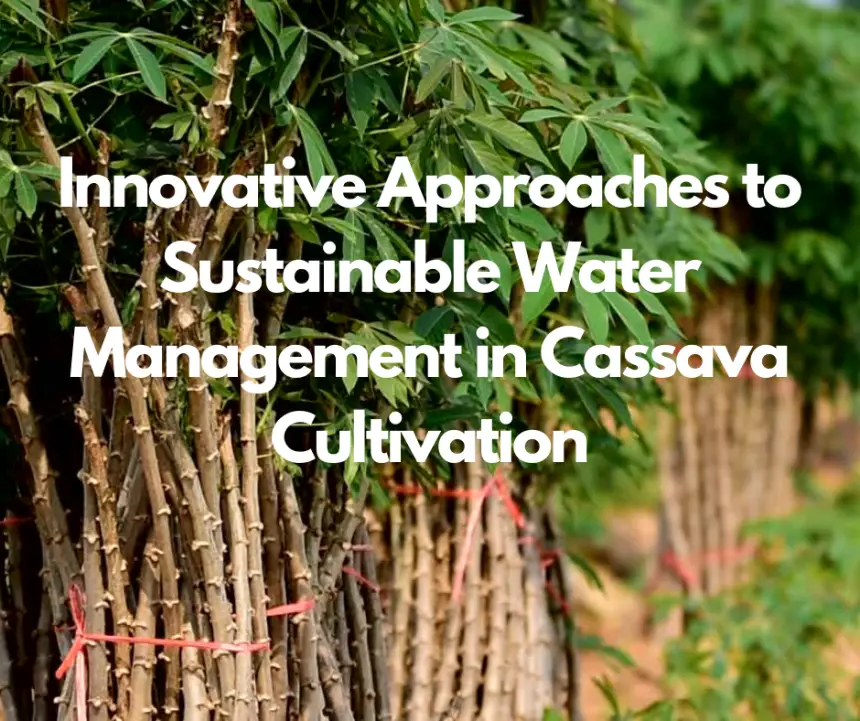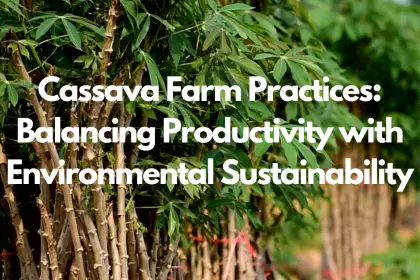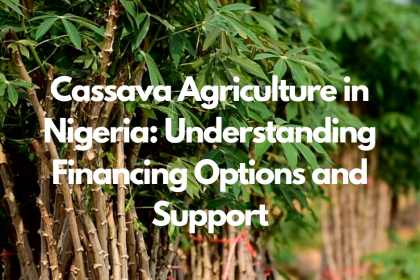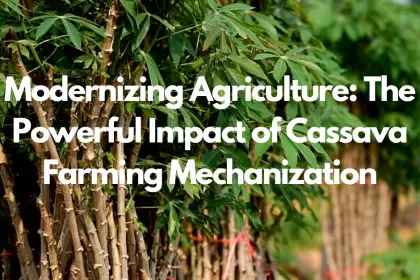
Cassava cultivation plays a pivotal role in the agricultural sector globally, especially in regions where the crop serves as a staple food source. As an essential component of cassava production, sustainable water management is increasingly becoming a focus among farmers and researchers alike. This emphasis on sustainability is even more critical in countries like Nigeria, where cassava production is a significant part of the economy and livelihood for many families.
This article delves into innovative approaches to sustainable water management in cassava cultivation, highlighting the importance of optimizing water usage to ensure crop health and yield. From innovative irrigation techniques tailored for cassava to crop diversification and the development of water-efficient cassava varieties, the article aims to offer insights and practical solutions for enhancing cassava yield in Nigeria and beyond, through effective water management strategies.
The Role of Cassava in Global Agriculture
Cassava has emerged as a resilient and versatile crop, pivotal in global agriculture for several reasons:
- Climate Resilience and Economic Potential: Studies, such as the one focusing on South African agriculture, underscore cassava’s resilience to climate risks and its potential for import substitution. Despite South Africa importing a significant amount of cassava starch, the country faces challenges like the absence of a comprehensive cassava research program and an established value chain for large-scale production and processing. This scenario presents a substantial opportunity for cassava in contributing to industrial starch production and job creation, particularly in rural areas.
- Global Production and Consumption Patterns:
-
- Nigeria stands as the world’s largest cassava producer, with production steadily increasing due to factors such as population growth, market demand, and improved varieties. Cassava’s role is not limited to human consumption; it also serves as animal feed and in industrial processes, highlighting its versatility.
- The crop’s significance extends beyond Africa to Asia and Latin America, thriving in tropical and subtropical regions. Its ability to grow in poor soil conditions and withstand dry periods makes it a high-yielding crop, essential for food security and economic opportunities in these regions.
- Socio-Economic Impact:
-
- The involvement of women in cassava production, processing, and marketing is noteworthy, contributing significantly to the agricultural labor force in various regions. This underscores the gendered dimensions of cassava cultivation and its importance in supporting female-dominated households.
- Organizations like the International Institute of Tropical Agriculture (IITA) have been instrumental in promoting cassava through the development of disease-resistant and high-yielding varieties, further enhancing its socio-economic impact.
Cassava’s role in global agriculture is multifaceted, offering solutions for climate resilience, economic development, and food security, while also presenting challenges that need addressing to unlock its full potential.
Principles of Sustainable Water Management
Ensuring the utilization of high-quality water for irrigation is paramount in cassava cultivation. Poor-quality water can detrimentally affect the growth and yield of cassava. A notable study utilizing the Soil and Water Analysis Tool (SWAT) in the White Volta Basin across Ghana and Burkina Faso demonstrated the tool’s efficacy in evaluating the hydrologic and water-quality response to increased cassava production. The SWAT model’s simulations under various cassava land-use scenarios provided insights into the impacts on water quality, notably:
- A reduction in nitrogen species loads and concentrations.
- A 4.21% increase in phosphate concentration.
These findings underscore the SWAT model’s reliability as a water quality model, aiding in the development of comprehensive environmental management plans.
Efficient water use and soil management practices are critical for cassava farming, given the crop’s sensitivity to waterlogged conditions which can lead to root rot and reduced yield. Key principles for sustainable water management in cassava cultivation include:
- Understanding Water Flows and Usage: Measuring water usage accurately is essential for efficient water management.
- Economic, Environmental, and Social Considerations: Incorporating these aspects into water management ensures sustainability across multiple dimensions.
- Adherence to Sustainable Practices: This encompasses farm selection, integrated crop management, soil protection, and management of yards.
- Mitigation of Diffuse Water Pollution: Adopting recommended farming practices to address water pollution from agricultural activities.
- Economic Sustainability: Effective water resource management is crucial for reducing costs, maintaining or improving productivity, and promoting financial stability.
- Social and Environmental Sustainability: Good water management practices should engage the community, build capacity, and minimize agriculture’s impact on water quality and availability.
The principles of sustainable water management in cassava cultivation are integral to achieving high yields, promoting economic viability, and ensuring environmental protection.
Innovative Irrigation Techniques for Cassava
Drip irrigation emerges as the cornerstone of water-efficient irrigation systems for cassava cultivation, offering numerous advantages that significantly impact crop yield and water conservation. Key benefits include:
- High Water Use Efficiency: Up to 90% efficiency, minimizing water wastage.
- Yield Enhancement: Studies indicate that cassava fields under drip irrigation can see yields increase by up to 30% compared to traditional methods.
- Soil Moisture Optimization: Ensures adequate soil moisture, reducing the risk of waterlogging and promoting healthy root development.
In contrast, furrow irrigation presents a simpler, yet effective alternative for cassava fields, particularly in areas with less sophisticated infrastructure. Its benefits include:
- Simple Implementation: Easy to set up and manage, requiring minimal technical knowledge.
- Water Conservation: When properly calibrated, it can reduce water usage by up to 50%, making it a cost-effective option for small to medium-sized farms.
Experimental trials in Nigeria have demonstrated the profound impact of precise irrigation on cassava production. Drip irrigation not only increases root yields sixfold in comparison to non-irrigated fields but also supports the development of strong, healthy plants. This is further evidenced by the success of drip irrigation in AyoKone’s chili farm, which is now being adapted for cassava with promising early results. The integration of fertigation techniques enhances this further by improving tuberization and water use efficiency across various cassava varieties.
Crop Diversification and Intercropping Strategies
Incorporating crop diversification and intercropping strategies into cassava cultivation presents a multifaceted approach to enhancing farm productivity, resilience, and environmental sustainability. These practices, grounded in good agronomic principles, offer a robust framework for managing erosion, optimizing land use, and improving ecosystem services. Below is a detailed exploration of the benefits and applications of these strategies:
- Erosion Management and Soil Health:
-
- Good agronomic practices, including reduced tillage and the establishment of contour hedgerows of grasses, effectively mitigate soil erosion.
- Intercropping cassava with other crops enhances soil structure and fertility, contributing to overall land productivity and health.
- Enhanced Ecosystem Services:
-
- Intercropping cassava with crops such as maize, beans, and various grain legumes yields positive effects on pest suppression, disease control, and soil and water conservation.
- These practices significantly reduce the prevalence of pests like whitefly and mealybugs, critical vectors for plant diseases, while also bolstering soil moisture and water infiltration rates.
- Optimized Land Use and Crop Resilience:
-
- Systems combining cassava with maize, beans, or grain legumes not only produce more food per unit of land but also exhibit a higher resilience to climate variability.
- The long duration of cassava allows for the cultivation of several companion crops, either simultaneously or sequentially, enhancing biodiversity and reducing the risk of crop failure.
These strategies underscore the importance of adopting a holistic approach to cassava cultivation, leveraging intercropping and diversification to achieve sustainable agricultural outcomes.
Enhancing Cassava Yield with Water-Efficient Varieties
Cassava’s growth and yield are significantly influenced by water availability, with its requirement of at least 50 mm of rainfall per month for a minimum of six months. Research highlights that:
- Water Supply and Yield Relationship:
-
- Higher water levels lead to increased yields.
- Insufficient water reduces crop yield and value.
- Optimal growth occurs with around 1,700 mm of rainfall during the fourth to eleventh month after planting.
Drought-Tolerant Varieties:
Developing cassava varieties that can withstand water stress is crucial. A study revealed that drought-tolerant varieties exhibiting traits such as higher photosynthetic efficiency, leaf retention, and an increased number of leaves under water-deficient conditions produced higher yields. The International Institute of Tropical Agriculture (IITA) and the CIAT breeding program have been instrumental in this regard, releasing varieties with enhanced drought tolerance and disease resistance, including:
- IITA Varieties: Ayaya, Farmer’s Pride, Fine Face, Sunshine, TME419, Dixon, Game Changer, Obasanjo-2, and Poundable. These varieties offer yields ranging from 30 to 38.7 tons per hectare, showcasing traits such as high yield and stability, attractive leaves, good root shape, and multiple pest and disease resistance.
- CIAT Clones: Known for better resistance to cassava bacterial blight, super-elongation disease, whiteflies, thrips, and root rot caused by Phytophthora water moulds. Additionally, CIAT has developed cold-tolerant varieties thriving up to 1,800 m above sea level and varieties with increased nutritional value, including higher vitamin A, iron, and zinc content.
These advancements in breeding for water-efficient cassava varieties are pivotal for enhancing cassava yield under varying water conditions, ensuring food security and economic stability in cassava-dependent regions.
Case Studies: Successful Implementations of Sustainable Practices
In the exploration of sustainable practices in cassava cultivation, two distinct studies provide valuable insights into the challenges and opportunities present in Nigeria’s cassava industry.
Case Study 1: Policy Sustainability Issues among Cassava Farmers in Ikorodu, Lagos, Nigeria
- Research Design: Participatory development theory with a focus on policy participation and sustainability.
- Key Findings:
-
- Volatility and uncertainty in the cassava business environment.
- Inadequate government support and policy inconsistency.
- Importance of planting high-yield cassava stems for improved productivity.
- Need for promotion, commercialization, and policy reformation in the cassava sector.
Case Study 2: Sustainability of Farm-Level Practices in Kwara and Nasarawa States, Nigeria
- Demographics: Predominantly male (94.1%) and married (97.7%) respondents within the age bracket of 18 to 55 years (79.6%).
- Influential Factors on Sustainable Practices:
-
- Positive impacts of educational level, mean technical efficiency, and extension contact.
- Significant constraint: Shortage of extension services (100%).
- Recommendations: Enhanced funding for research, sustainable practices, and comprehensive extension services.
Both case studies underscore the critical role of policy stability, government support, and sustainable farm management practices in enhancing cassava yield and livelihoods. The emphasis on high-yield varieties, soil health, and nutrient management highlights the multifaceted approach required for sustainable cassava cultivation in Nigeria.
Conclusion
This article has highlighted a broad array of innovative and sustainable water management practices, crucial for optimizing cassava cultivation, particularly in regions where this crop holds significant economic and nutritional importance. The incorporation of advanced irrigation techniques, alongside strategies such as crop diversification and the development of water-efficient cassava varieties, showcases not only the adaptability of cassava to various environmental challenges but also its potential to contribute more significantly to food security and economic stability. Through a dynamic exploration of research findings, case studies, and practical implementations, we’ve established a comprehensive understanding of how sustainable practices can enhance cassava yield while ensuring environmental protection.
Moving forward, it is paramount for stakeholders in cassava cultivation – from farmers to policymakers – to embrace these practicable solutions and integrate them into everyday farming activities. The demonstrated economic, environmental, and social benefits underscore the necessity for continued investment in research, policy enhancement, and the promotion of sustainable practices. As we strive for agricultural advancements, the principles and strategies outlined in this piece offer a roadmap towards more resilient and productive cassava cultivation, serving as a cornerstone for future development in this critical agricultural sector.
FAQs
What is the optimal irrigation system for growing cassava?
The most water-efficient method for irrigating cassava is drip irrigation. This system conserves water by providing small, frequent applications, which not only saves water but also maintains the soil moisture at a level that promotes the growth of the cassava plants while minimizing water supply to weeds.
What are the recommended practices for successful cassava cultivation?
For optimal cassava growth, it’s important to have an annual rainfall of at least 1000 mm, with a consistent rainy season lasting a minimum of 6 months and monthly rainfall not dropping below 50 mm. The soil should be well-drained, deep (at least 30 cm), and free from sand, clay, stones, or salt. In areas prone to waterlogging, it’s advisable to plant cassava on raised mounds or ridges to ensure proper drainage.
Which irrigation technique is best suited for cassava crops?
Drip irrigation stands out among various irrigation techniques, such as sprinkler systems, flood irrigation, or center pivot irrigation, as the best-suited method for cassava. It ensures the soil remains in a condition that is highly favorable for the growth of cassava crops.
How much water does cassava require?
Cassava plants typically need about 0.8 cups of water every 9 days when they are not exposed to direct sunlight and are planted in a 5.0″ pot. However, this is a general guideline, and water requirements can vary based on the specific environment. To obtain more accurate watering recommendations tailored to your conditions, you can use a water calculator or download an app like Greg for advanced plant care advice.









